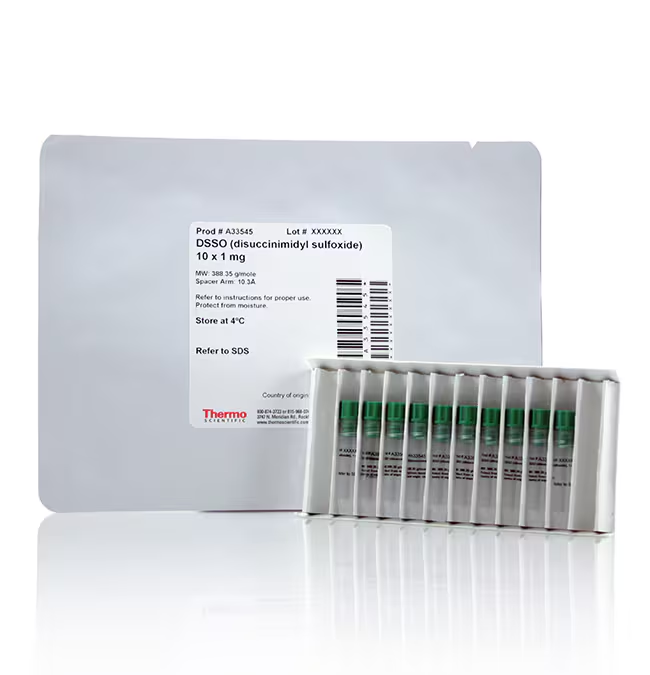
Chemical crosslinking in combination with mass spectrometry is a powerful method to improve protein characterization and identification of protein-protein interactions. This method has been applied to recombinant and native protein complexes and, more recently, to whole cell lysates or intact unicellular organisms in efforts to identify protein-protein interactions on a global scale. The more recent enhancement of cleavability in DSSO and DSBU has improved MS compatibility and sensitivity of detection of crosslinked peptides and proteins.
DSSO (disuccinimidyl sulfoxide) and DSBU (disuccinimidyl dibutyric urea or BuUrBU) are both mass spectrometry (MS)-cleavable and membrane-semi-permeable crosslinkers that contain an amine-reactive N-hydroxysuccinimide (NHS) ester at each end of a 7-carbon spacer arm (DSSO) or 11-atom spacer arm (DSBU). Both crosslinkers have reactivity similar to DSS but contain a cleavable functionality in the linker region that enables cleavage in the gas phase using collision-induced dissociation (CID) during tandem MS (MS/MS) fragmentation. The MS cleavage of DSSO or DSBU generates diagnostic ion doublets during MS2, which distinguishes identification of crosslinked peptides from dead-end modifications. The crosslinked peptide fragments are subsequently identified using MeroX or XlinkX software. For DSBU, crosslinked peptides are fragmented and sequenced during MS2, while for DSSO, crosslinked peptides are fragmented during MS/MS and require additional fragmentation (MS3) to facilitate peptide sequencing using traditional database search engines.
Features of MS-cleavable crosslinkers DSSO and DSBU
• Highly reactive NHS ester (at both ends) with primary amines
• MS-cleavable by collision-induced dissociation (CID)
• High-purity crystalline reagents for protein structure and interaction characterization
• Membrane-semi-permeable, allowing intracellular crosslinking
• Water-insoluble (dissolve first in DMF or DMSO)
Benefits of MS-cleavable crosslinkers
Although both non-cleavable and MS-cleavable crosslinkers can be used to study protein-protein interactions, MS-cleavable crosslinkers may be more advantageous to improve identification and analysis of crosslinked peptides. Typically when using non-cleavable crosslinkers, the data generated consists of both the crosslinked and non-crosslinked peptides, making it difficult to distinguish using mass spectrometry analysis. Non-cleavable crosslinkers also increase the complexity of the analysis. Some complexity can be reduced through additional sample preparation or through isotopic labeling. MS-cleavable crosslinkers provide the ability to distinguish between crosslinked and non-crosslinked peptides for analysis. The crosslinker is cleaved through collision induced dissociation (CID/HCD) or electron transfer induced dissociation (ETD) to generate characteristic ions that can then be used during MS2 or MS2/MS3 fragmentation to confidently identify and sequence crosslinked peptides. The ability to unambiguously identify crosslinked peptides results in fewer false positives when compared to non-cleavable crosslinkers. DSSO and DSBU utilize a sulfoxide or urea, respectively, for cleavability with gas phase fragmentation.
Applications for MS-cleavable crosslinkers DSSO and DSBU
• Analyzing complex protein mixtures
• Profiling native protein-protein networks in vivo
• Investigating intact organelles, cells, or tissues
• Performing proteome-wide studies
• Characterizing intermolecular protein interactions
• Characterizing purified proteins and complexes
Note: For high resolution analysis of the crosslinked peptides, the recommended LC column for the Nanospray Flex source is the Acclaim PepMap 100 C18 LC Column (Cat. No. 164940 or 164568). For the EASY-Spray source, the recommended LC column is the EASY-Spray C18 LC Column (Cat. No. ES900 or ES904).
| Code | Description |
|---|---|
| A33545 | Catalog Number: A33545 Unit Size: 10 x 1 mg Description: DSSO |
| A35459 | Catalog Number: A35459 Unit Size: 10 x 1 mg Description: DSBU |

